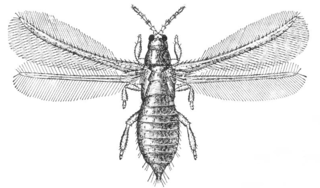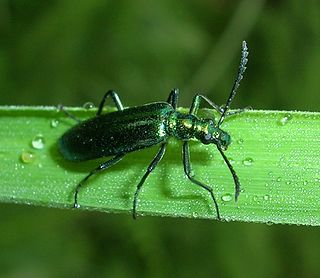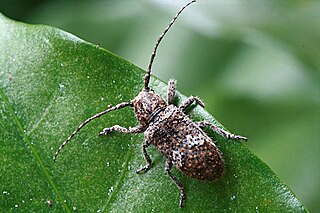
Ochodaeidae, also known as the sand-loving scarab beetles, is a small family of scarabaeiform beetles occurring in many parts of the world.

The Thripidae are the most speciose family of thrips, with over 290 genera representing just over two thousand species. They can be distinguished from other thrips by a saw-like ovipositor curving downwards, narrow wings with two veins, and antennae of six to ten antennomeres with stiletto-like forked sense cones on antennal segments III and IV.

The northern snake-necked turtle or northern long-necked turtle is a species of turtle in the family Chelidae or Austro-South American Side-necked Turtles. It is native to northern Australia and southern New Guinea.
Ascioplaga is a genus of beetles in the family Cupedidae, one of the six extant families within the Archostemata beetle group. .containing two species endemic to New Caledonia and one described from northern Queensland in Australia.. The Australian species, Ascioplaga scalena, was originally described as a species of Adinolepis, and was transferred to Ascioplaga in 2009. Research on this species’ internal head anatomy, specifically mouthparts and musculature, clarified evolutionary aspects of this species and its deeper role in the Coleoptera group..

Prionoceridae is a small family of beetles, in the suborder Polyphaga. They form a group within the cleroid beetles and were formerly treated as a subfamily (Prionocerinae) within the family Melyridae. Very little is known of their life history but most species are pollen feeders as adults and occur in large numbers during spring or the host flowering season. Larvae are predatory or feed on decomposing wood.

Helotidae is a family of beetles, in the suborder Polyphaga. The family includes about five extant genera, Helota MacLeay, Neohelota Ohta, Afrohelotina Kirejtshuk, Metahelotella Kirejtshuk, and Strophohelota Kirejtshuk. Helotidae are found mainly in the Old World tropics and are absent from Australia and Madagascar. The antennae are clubbed on the final three segments and is retractable within grooves under the head. The wings have reduced venation with just 4 anal veins. Helotids are known to be associated with sap, fruit and flowers, and the larvae of some species are known to bore into wood in order to pupate.

Dasypoda is a genus of bees in the family Melittidae.

Desmiphorini is a tribe of longhorn beetles of the subfamily Lamiinae.

Rhytiphora is a genus of flat-faced longhorn beetles in the Pteropliini tribe of the subfamily Lamiinae. The genus was first described in 1835 by Jean Guillaume Audinet-Serville.

Rhytiphora bankii is a species of beetle in the family Cerambycidae. It was first described by Johan Christian Fabricius in 1775, under the genus Lamia. It is known from Australia, the Philippines, Borneo, Java, Micronesia, New Guinea, Hawaii, Moluccas, Sumatra, Vietnam, and has been introduced into Japan. The Australian species of Prosoplus were synonymised with Rhytiphora in 2013.

Acrocera orbiculus, also known as the top-horned hunchback, is a species of fly belonging to the family Acroceridae. The species has a holarctic distribution, ranging from North America to the Palaearctic.
Rhytiphora albolateralis is a species of beetle in the family Cerambycidae. It was first described by Stephan von Breuning in 1938 as Saperdopsis albolateralis. In 1961 von Breuning transferred it to the genus, Rhytiphora. It is known from Australia, its holotype having been collected in Cooktown.

Simplocariini is a tribe of pill beetles in the family Byrrhidae. There are about 9 genera and more than 40 described species in Simplocariini.
Symballophthalmus is a genus of flies in the family Hybotidae.
Dumbea is a genus of leaf beetles in the subfamily Eumolpinae. It is known from the South Province and Mont Panié of New Caledonia, and is named after Dumbéa, a town nearby Nouméa. This name was originally used by the French entomologist Charles Adolphe Albert Fauvel to house several species of Eumolpinae from New Caledonia, but Fauvel's Dumbea was unpublished and is a nomen nudum. The genus was established based on general proportions and body size, and may be polyphyletic or paraphyletic.

Rhopalomma is an extinct genus of ommatid beetle. It is known from a single species, Rhopalomma stefaniae described from the Upper Jurassic (Tithonian) Talbragar fossil locality in New South Wales, Australia.

Phintella globosa is a species of jumping spider in the genus Phintella that lives in Ivory Coast. First described by Wanda Wesołowska and Anthony Russell-Smith in 2022, the spider is small, with a cephalothorax typically 2.1 mm (0.083 in) long and an abdomen 2.0 mm (0.079 in) long. Only the female has been described. The carapace is dark brown and the abdomen yellow. Although similar to the related Phintella lucida, the copulatory organs are distinctive. The spermathecae are particularly large and spherical, which is recalled in the species name.

Phintella transversa is a species of jumping spider in the genus Phintella that lives in Ivory Coast. First described by Wanda Wesołowska and Anthony Russell-Smith in 2022, only the male has been identified. The spider is small, with a cephalothorax between 2.0 and 2.4 mm long and an abdomen that is between 2.1 and 2.4 mm long. The carapace is dark brown and the abdomen is brownish-black and marked with four light, nearly white streaks. It is that abdominal pattern that most clearly distinguishes the species from others in the genus and is recalled in the species name. The copulatory organs are also distinctive. The palpal bulb has a small triangular lobe on the back and a curved addition near the small embolus.

Phintella brevis is a species of jumping spider in the genus Phintella that lives in Ivory Coast. First described by Wanda Wesołowska and Anthony Russell-Smith in 2022, the spider is small, with a cephalothorax between 2.0 and 2.1 mm long and an abdomen between 1.9 and 2.0 mm long. Only the female has been described. The carapace is brown and the abdomen yellow. Although similar to the related Phintella lucida, the copulatory organs are distinctive, particular the tip of the spike on the tibia, the tibial apophysis.












